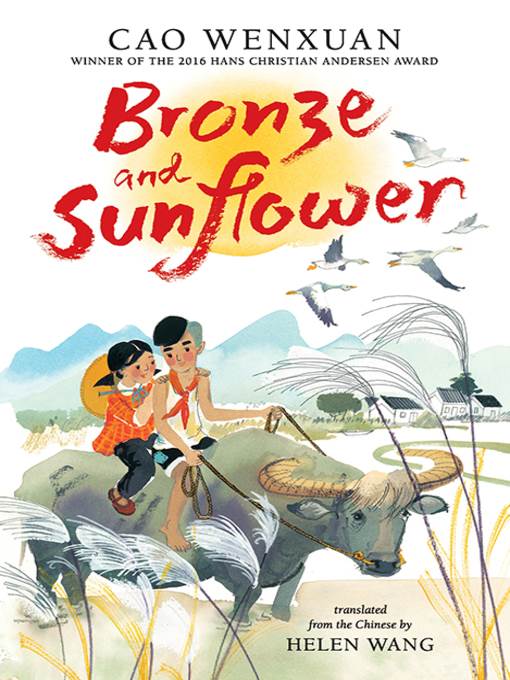
Bronze and Sunflower
فرمت کتاب
ebook
تاریخ انتشار
2017
Lexile Score
790
Reading Level
3-4
ATOS
5.6
Interest Level
4-8(MG)
نویسنده
Meilo Soناشر
Candlewick Pressشابک
9780763693688
کتاب های مرتبط
- اطلاعات
- نقد و بررسی
- دیدگاه کاربران
نقد و بررسی

Starred review from December 19, 2016
Hans Christian Andersen Award–winner Wenxuan’s moving story of a friendship between two lonely Chinese children, orphaned Sunflower and mute Bronze, bears all the elements of a classic: an inviting and solidly constructed setting, a close-knit family, and a kindhearted community (there’s even a pet buffalo). Traversing five years, the book is beautifully translated into lyrical prose that brings to life the riverside village of Damadai (“The glints of sunlight on the water rippled into a golden glow that rose and fell with the river”) and its inhabitants, especially Bronze’s impoverished family, who adopt Sunflower—a stranger from the city—after her father’s drowning. The two children grow inseparable, becoming each other’s protectors as the family and community persevere through the small and large dramas of life in rural China. While the story seems timeless, a closing note explains that it takes place during the Chinese Cultural Revolution of the late 1960s and early 1970s, and describes the cadre schools that brought people like Sunflower and her father from the city to the remote countryside. Ages 9–12.

February 1, 2017
Gr 4-6-The landscape, captured in lyrical, evocative prose, takes the leading role in this episodic novel set during China's Cultural Revolution. From the start, readers are drawn into the tiny village of Damaidi, a world circumscribed by a seemingly endless reed marsh, a "vast ocean, rippling with green waves." A broad river serves as the symbolic and literal divide between the village and the Cadre School, a settlement of city dwellers sent to the countryside to tame the wilderness. Against this backdrop, we meet lonely Sunflower, age seven, who has accompanied her father to the Cadre School, and Bronze, the 11-year-old son of the poorest village family, who is unable to speak. When Sunflower's father drowns in an unusual and unfortunate sequence of events, the girl is adopted by Bronze's family, and the pair become fast friends, accompanied in their adventures by the family's water buffalo, a delightful sidekick, "more placid and better natured than most humans." Long as this work is on eloquence and charm, its core strength is its unflinching portrayal of the harsh realities of life in rural China. The family suffer through several catastrophes, including near starvation following a plague of locusts, but perhaps more telling are the endless small embarrassments of poverty. In one sequence, Sunflower pretends to visit friends when in reality she needs a place to do homework because her family can't afford oil for their lanterns.
Copyright 2017 School Library Journal, LLC Used with permission.

Starred review from January 1, 2017
Set during China's Cultural Revolution (1960s-70s), this import follows the trials and tribulations of a poor, rural family.Sunflower accompanies her artist father to the countryside, where he undergoes political reform at a labor camp. Left on her own for most of the day, Sunflower longs to play with the village children across the river. When her father tragically drowns, Sunflower is taken in by Bronze's family, the poorest family in Damaidi village. Bronze, who is mute, and Sunflower form an instant bond and become inseparable. In Wang's translation of his leisurely, languid prose, Hans Christian Andersen winner Cao captures both the infinite joys and harsh realities of rural farming life: Sunflower and Bronze picking wild plants or catching fish; the family's struggle to rebuild their house after a storm. Yet despite their adversities, the close-knit family members remain fiercely loyal: Bronze hoists Sunflower on his shoulders and stands for hours so she can watch a circus; Sunflower deliberately fails her exams so the money for her schooling can be used for Nainai's medical expenses. Eventually, the family makes the ultimate sacrifice but does it with the same grace and resolute strength they've demonstrated throughout the story. While seemingly idealized, the story and its protagonists reflect the Confucian values of filial piety and society above self--the very foundation of Chinese culture. Readers of all ages should be prepared to laugh, cry, and sigh with satisfaction. (historical note, author's note) (Historical fiction. 9-14)
COPYRIGHT(2017) Kirkus Reviews, ALL RIGHTS RESERVED.

Starred review from February 1, 2017
Grades 4-6 *Starred Review* When Bronze and Sunflower meet on the banks of the rushing river, they know they are kindred spirits. Sunflower is small and quick, while mute Bronze is patient and calm. When Sunflower's artist father suddenly dies in a tragic river accident, she is taken in by Bronze's poor but hardworking family in the tiny rural village of Damaidi, China. Over several years, readers follow the family as they celebrate the good things in lifethe circus, Sunflower starting school, a handmade giftand the badfamine, flood, and the loss of their beloved grandmother, Nainai. Translated from Mandarin, the confident, well-paced, episodic storytelling alternates laughter and tears. The vivid imagery employs all the senses, evoking emotions and creating beautiful moments of reflection about the natural world. Written by a cultural insider, this story provides a window into life as a child in rural China near the end of the Cultural Revolution. Virtuous and kind, Bronze and Sunflower's family reflects important cultural values including filial piety, respect for elders, the value of hard work and education, and the importance of saving face. This not-to-be-missed story reminds us to be thankful for family and love, no matter our station in life. Helpful back matter provides additional insight into this specific time in China's history.(Reprinted with permission of Booklist, copyright 2017, American Library Association.)

























دیدگاه کاربران